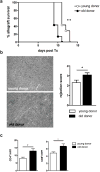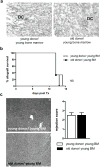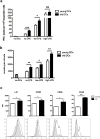CD11c+ Dendritic Cells Accelerate the Rejection of Older Cardiac Transplants via Interleukin-17A
- PMID: 25957225
- PMCID: PMC4503506
- DOI: 10.1161/CIRCULATIONAHA.114.014917
CD11c+ Dendritic Cells Accelerate the Rejection of Older Cardiac Transplants via Interleukin-17A
Abstract
Background: Organ transplantation has seen an increased use of organs from older donors over the past decades in an attempt to meet the globally growing shortage of donor organs. However, inferior transplantation outcomes when older donor organs are used represent a growing challenge.
Methods and results: Here, we characterize the impact of donor age on solid-organ transplantation using a murine cardiac transplantation model. We found a compromised graft survival when older hearts were used. Shorter graft survival of older hearts was independent of organ age per se, because chimeric young or old organs repopulated with young passenger leukocytes showed comparable survival times. Transplantation of older organs triggered more potent alloimmune responses via intragraft CD11c+ dendritic cells augmenting CD4+ and CD8+ T-cell proliferation and proinflammatory cytokine production, particularly that of interleukin-17A. Of note, depletion of donor CD11c+ dendritic cells before engraftment, neutralization of interleukin-17A, or transplantation of older hearts into IL-17A(-/-) mice delayed rejection and reduced alloimmune responses to levels observed when young hearts were transplanted.
Conclusions: These results demonstrate a critical role of old donor CD11c+ dendritic cells in mounting age-dependent alloimmune responses with an augmented interleukin-17A response in recipient animals. Targeting interleukin-17A may serve as a novel therapeutic approach when older organs are transplanted.
Keywords: aging; immunology; rejection; transplantation.
© 2015 American Heart Association, Inc.
Figures






References
-
- Kocot A, Giessing M. Increasing the donor and recipient pool-expanded criteria in living kidney donors. Transplant Proc. 2013;45:1245–1247. - PubMed
-
- Cevenini E, Monti D, Franceschi C. Inflamm-ageing. Curr Opin Clin Nutr Metab Care. 2013;16:14–20. - PubMed
-
- Tullius SG, Milford E. Kidney Allocation and the Aging Immune Response. N Engl J Med. 2011;364:1369–1370. - PubMed
-
- Romanyukha AA, Yashin AI. Age related changes in population of peripheral T cells: towards a model of immunosenescence. Mech Ageing Dev. 2003;124:433–443. - PubMed
-
- Rink L, Cakman I, Kirchner H. Altered cytokine production in the elderly. Mech Ageing Dev. 1998;102:199–209. - PubMed
Publication types
MeSH terms
Substances
Grants and funding
LinkOut - more resources
Full Text Sources
Other Literature Sources
Medical
Molecular Biology Databases
Research Materials
Miscellaneous

